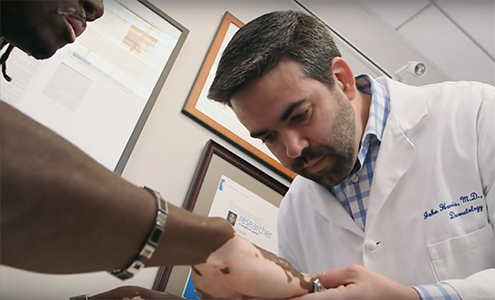Major gift will accelerate vitiligo research
June 2019

People with vitiligo are rarely anonymous. The autoimmune disease that attacks their pigment cells leaves white marks on their skin, often on their faces and hands, showing their condition to the world.
A donor with an interest in vitiligo, however, chose to remain anonymous while making a $700,000 gift to speed up the groundbreaking work of the Vitiligo Clinic and Research Center at UMass Chan Medical School.
“This is an incredibly important gift,” said John E. Harris, MD, PhD, associate professor of dermatology and director of the vitiligo clinic. “We are so grateful for this support. It will speed up our work and, I hope, help us discover more about the processes of this disease.”
Dr. Harris earned both his doctorate and medical degree at UMMS, and has become a world leader in vitiligo research. Last year, he and colleagues published results of an important discovery that exposed a potential target to shut down the cells that cause this disease. That research could eventually lead to more effective treatments for the estimated 75 million people in the world with vitiligo.
Today, however, the standard of care for vitiligo has changed very little since Harris saw his first vitiligo patient some 15 years ago in UMass Memorial Medical Center’s Intensive Care Unit (ICU). At the time, Harris’s research mentor, the late Aldo Rossini, MD, who led diabetes research at UMass for years, knew that Harris was seeking direction for his budding medical career.
Harris was intrigued by the processes of autoimmunity. He wanted to know more about how, and why, our immune system can mistakenly attack heathy tissues. His doctoral research focused on the processes of type 1 diabetes, but Harris didn’t want to become an endocrinologist.
“Aldo knew that I was searching, and I believe he purposely brought me in to see his patient, who had simultaneously developed type 1 diabetes and vitiligo, which is not uncommon, because they share a similar genetic predisposition,” Harris said.
When Harris examined the patient and saw the white patches of skin, it was a turning point. He was both moved by the impact the disease has on patients and energized by the realization that, as a skin disease, it would be possible to do research on the actual human cells involved in vitiligo.
“It’s an incredible advantage to have easy access to tissues from living patients who we can track over time,” Harris said.
Since then, Harris and his lab team have built an extensive research program, developing new techniques to study vitiligo and to analyze cells from patients. They can compare healthy skin cells with those that have lost pigment. They first look at immune system cells that attack the pigment cells, then compare them to those that do not. Then, in theory, they could compare the molecular processes in all of those cells, across multiple patients.
And that is where the challenge lies. Harris has collected 40,000 skin cells from the skin of consenting vitiligo patients and healthy controls. Using the latest RNA-sequencing technology for single cells, it is possible to identify the expression of hundreds of genes in each cell that may play a role in this disease. Therefore, Harris has built a huge data base of molecular information that requires new software and advanced algorithms to analyze. He is working with Manuel Garber, PhD, associate professor and director of the Bioinformatics Core at UMMS, on that effort.
Harris says this is like looking for needles in a haystack the size of a mountain. The $700,000 donation will be used to develop the tools needed and to begin mining this mountain of data.
“We hope to find many needles that will not only help with understanding vitiligo, but potentially reveal information about other autoimmune diseases,” Harris said. “There is so much data, it will literally take us years. So, the more support we have, the faster we can work through it. We could not do these important, early studies, without donor support.”
